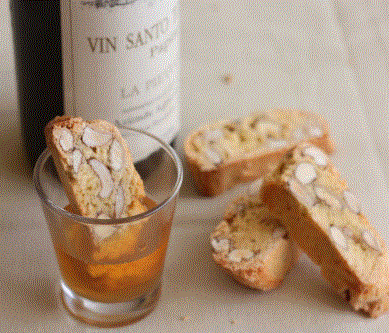Italians are very particular about what they dip their biscotti into. Pretty much it is a list of one – Vin Santo. An Italian Food Rule — Only Dip Biscotti in Vin Santo, Not in Coffee.
There is nothing more satisfying for dessert at the end of a long Italian meal than a couple of almond -studded biscotti and a small glass of Vin Santo. The hard biscotti become sweetly moist after a few seconds dipped in the sweet late-harvest wine. Not too filling. Just a sweet note to the perfect repast. All that’s needed is a shot of espresso to send you on your way. But don’t make the mistake of dipping one extra biscotto into the coffee.
The subtly sweet, crisp almond cookies, loved throughout the world, have their origin in Italy. The word biscotti is the plural form of biscotto, which originates from the ancient Latin word biscoctus, meaning “twice-baked.”
Since they are very dry and can be stored for long periods of time, biscotti became a common food for long journeys, warring armies and sea voyages. Pliny the Elder boasted that such goods would be edible for centuries. They were a staple food of the Roman Legions and it is said Christopher Columbus carried these cookies on his voyages because they were so sturdy, and their dryness prevented the problem of spoilage.
While the word can refer to any crunchy cookie, it usually is used to describe the twice-baked almond cookies known as cantucci or cantuccini in Tuscany. In the Florence, they’re known as Biscotti di Prato because the most famous version of this cookie comes from the historic bakery Mattei in Prato, founded in 1858. Antonio Mattei was a friend of Pellegrino Artusi, who included some of Mattei’s recipes in The Science of Cooking and the Art of Eating Well (1891). Mattei’s Biscotti di Prato are rich with eggs, almonds and pine nuts, no artificial flavors. The first documented recipe for the biscuit is a centuries-old manuscript, now preserved in Prato, found by the eighteenth-century scholar Amadio Baldanzi. In this document, the biscuits are called Biscotti of Genoa.
By baking them twice, they lose any excess moisture, which ensures a crisp, dry cookie perfect for dipping. In Vin Santo.
Vin Santo or Vino Santo (holy wine) is a style of Italian dessert wine. Traditional in Tuscany, these wines are often made from white grape varieties such as Trebbiano and Malvasia. After the late-harvested grapes destined for Vin Santo are picked, they are hung in warm, well-ventilated rooms that allow the moisture in the grape to evaporate. This process allows the sugars in the grape to be more concentrated. The longer the grapes are allowed to dry , the higher the resulting residual sugar levels will be in the wine.
Depending on the style of wine desired, the grapes may be crushed and the fermentation process started after a few weeks or not until late March (the association with Easter is a possible reason for the name). Producers may use a starter culture of yeast known as a madre that includes a small amount of finished Vin Santo from previous years production. It is believed that this older wine can help jump start the fermentation process and also add complexity to the wine.
After fermentation the grapes are then aged in small oak barrels. In many DOC regions, the wines are required to age for at least 3 years though it is not uncommon for producers to age their wines for 5 to 10 years. Traditionally the barrels were made of chestnut instead of oak, which contributed high amounts of wood tannins and was very porous, which promoted evaporation from the barrel. Under this same traditional style of winemaking, a large air space will emerge in the barrel and oxidation takes place. The high sugar content prevents the wine from turning to vinegar.
Although the style of making wine from dried grapes has been around almost as long as wine has been made, there are many theories on how the particular name Vin Santo or “holy wine” came to be associated with this style of wine in Italy. The most likely origin was the wine’s historic use in religious Mass, where sweet wine was often preferred. One of the earliest references to a ‘vinsanto’ wine come from the Renaissance era sales logs of Florentine wine merchants.


